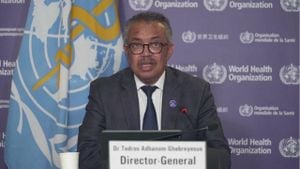Water resource challenges across the northeastern United States have intensified, with drought conditions giving rise to numerous issues for communities relying on these precious resources. Recent events, including historically low reservoir levels and growing fears surrounding lead contamination, highlight the urgent need for effective water management and community engagement.
New York City officials have sounded the alarm as reservoir levels plunge after months of minimal rainfall. Mayor Eric Adams declared a drought watch earlier this month, advising residents to conserve water, fix leaks, and take shorter showers. Despite these voluntary measures, water supplies have been increasingly stressed, with the Schoharie Reservoir reportedly at less than one-third capacity. The situation is dire; the overall water system is currently at about 63% of its normal capacity, down from around 79%, according to Paul Rush, head of the city’s water supply.
This troubling decline coincides with the temporary shutdown of the Delaware Aqueduct, which typically provides more than half of New York City's water supply. The aqueduct's repair project, aimed at addressing leaks in this aging infrastructure, is certainly necessary but the timing raises concerns about water availability. Flooding streams and snowmelt are often relied upon to replenish reservoir levels, yet both have been conspicuously absent this season.
At the same time, Syracuse residents are grappling with alarming news about lead contamination levels detected within their drinking water. Following routine checks, several homes and buildings revealed elevated lead levels raising fears among the community. Darlene Medley, a concerned resident, voiced her anxieties, noting her past experiences with lead poisoning. She expressed: “It’s terrifying. I must now keep bottled water, not only for them to drink but also to cook.”
The city's initial response, which indicated false results due to testing issues, has done little to assuage public concern. Exposure to lead is known to adversely affect children's health, leading to issues like lower IQ and learning difficulties. The parallels to the Flint water crisis back in 2014, where similar neglect led to disastrous health consequences, are not lost on the community. Erik Olson from the Natural Resources Defense Council decried the situation, urging authorities to view this as the start of a drinking water crisis deserving immediate attention.
With the realities of climate change bearing down on the region, water resource management cannot be underestimated. Reportedly, conditions across sections of Pennsylvania are also following suit with drought monitoring indicating moderate to severe patterns, exposing more than just drinking water vulnerabilities. Recently, Lake Youghiogheny saw the Great Crossings Bridge emerge from its depths, last visible six years ago due to drought conditions. This occasion has attracted visitors but also sparked fears of structural integrity and physical safety as it poses risks if tampered with.
Meanwhile, the Great Lakes region is observing significant fluctuations as weather patterns shift dramatically. Data from the Army Corps of Engineers indicates Lake Superior and Lake Michigan-Huron have recorded drops of up to 7 inches compared to last year. Although Lake Erie and Lake St. Clair are above average, this should not overshadow the concerning trend of diminishing levels elsewhere.
Without substantial precipitation, projections for December suggest continued declines across all involved lakes, which could impact industries reliant on these waterways. Given their importance for transportation and commerce, stakeholders must stay alert to changes and develop strategic plans to manage these successfully.<\/p>
These combined issues surrounding water scarcity—from infrastructure challenges to health concerns related to lead poisoning—underscore the complex network of factors impacting water resources across the Northeast. The urgency for policymakers, environmental advocates, and local communities alike to call for investment and innovative solutions has never been more pressing.
While the challenges appear formidable, they are not insurmountable. With thoughtful engagement and community-led advocacy, solutions can emerge to mitigate the adversities faced by residents throughout the Northeast, ensuring safe, clean, and adequate water supply for generations to come.



